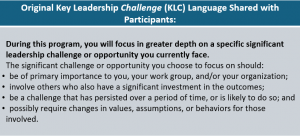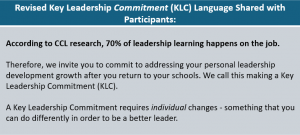By: Micela Leis
At CCL, we know that leadership development goes beyond teaching; it’s about ensuring strategies and skills are applied to real-world challenges1. This process of being able to apply skills, knowledge, and abilities learned in one context to another is known as learning transfer2 and is a critical component of successful leadership development3. However, fostering effective learning transfer can be challenging, often resulting in a gap between what is learned and what leaders actually apply in their organizations4. Why does learning transfer happen for some people and not others? How can leadership program designers and facilitators make learning transfer happen for everyone?
This blog post explores how a simple shift in framing can dramatically improve learning transfer. We use a case study from the Margaret Waddington Institute for School Leaders (Waddington) to illustrate the transformative power of reframing and its potential to drive meaningful change and growth in leaders.
Case Study: Reframing the Key Leadership Challenge
CCL provides free leadership development to principals and educational leaders in Vermont through the Margaret Waddington Institute for Leadership Development (Waddington), a program funded by an endowment from the Estate of Dr. Margaret Waddington. Waddington follows a cohort-based model, with the same group of principals coming together multiple times over a year to focus on leading themselves, leading with others, and leading in their organizations. Waddington also includes individualized executive coaching sessions, relevant books and readings, and leadership tools. Additionally, the program includes a Key Leadership Challenge (KLC) component, designed to encourage participants to apply their leadership learnings to real-world situations.
The Problem: The Disconnect Between Training and Application
In the original design of the KLC, participants were asked to identify a significant challenge in their professional roles and propose a solution. The intent was to encourage the application of learned leadership strategies to participants’ real-world challenges. The original KLC was described to participants in the following way:
 During the program, we observed a critical disconnect between the purpose of the KLC and how participants used it. While participants identified relevant challenges, their proposed solutions often did not reflect the strategic application of the leadership skills they had learned. Instead, the solutions were more reactive, focusing on immediate problem-solving rather than strategic leadership. For example, one participant identified their KLC as enhancing school culture and teacher satisfaction during teacher-development days. Their proposed solution was to bring donuts to meetings to uplift morale. While this solution could potentially have a positive impact, it failed to reflect the true purpose of the KLC: to help participants take what they’ve learned in their program and bring those lessons to life in their organizations and communities, leading to sustainable improvements in the participants’ leadership practices.
During the program, we observed a critical disconnect between the purpose of the KLC and how participants used it. While participants identified relevant challenges, their proposed solutions often did not reflect the strategic application of the leadership skills they had learned. Instead, the solutions were more reactive, focusing on immediate problem-solving rather than strategic leadership. For example, one participant identified their KLC as enhancing school culture and teacher satisfaction during teacher-development days. Their proposed solution was to bring donuts to meetings to uplift morale. While this solution could potentially have a positive impact, it failed to reflect the true purpose of the KLC: to help participants take what they’ve learned in their program and bring those lessons to life in their organizations and communities, leading to sustainable improvements in the participants’ leadership practices.
The Solution: Reframing Challenge to Commitment
Recognizing this disconnect, we embarked on a process to reframe the KLC. Our goal was to shift the focus from problem-solving to a thoughtful and intentional application of leadership strategies, thereby improving learning transfer. The first step in this process was a change in terminology. We replaced the term ‘Challenge’ with ‘Commitment’ in the KLC, and changed the way it was shared with participants. This reframing was not a mere cosmetic change but a strategic shift. By reframing the KLC as a commitment rather than a challenge, we emphasized the need for participants to implement the leadership strategies learned during the program in their daily work.
 In addition to this reframing, we developed a workbook, the Key Leadership Commitment Navigator, to guide participants through the KLC process, thus supporting learning transfer. The Navigator aids participants in transforming their leadership learning into actionable commitments by providing:
In addition to this reframing, we developed a workbook, the Key Leadership Commitment Navigator, to guide participants through the KLC process, thus supporting learning transfer. The Navigator aids participants in transforming their leadership learning into actionable commitments by providing:
- Examples of Commitments: Sample commitments related to the leadership content areas covered in the program.
- Motivation Survey: A survey to help participants assess their beliefs about the value of their KLC and their commitment to it.
- Guidelines for Making KLCs Actionable: Instructions on how to frame their commitment as a question.
- Learning Plans: Prompts for creating learning plans to implement KLCs within participants’ organizations, along with example learning plans.
The Impact of Reframing
We introduced the reframed KLC language and KLC Navigator to the next cohort of participants. The impact of this new approach yielded powerful results:
- Commitments to Apply Leadership Strategies: 100% of participants made commitments directly related to applying the leadership strategies learned during the program, up from 60% in the previous cohort. For instance, one principal, facing a challenge similar to a previous participant who used a less strategic approach (giving donuts to improve school culture), committed to providing both positive and developmental feedback to each teacher based on collaborative observations. This approach represents the application of leadership strategies to a new context and challenge.
- Increased Confidence in Tackling Challenges: Participants’ confidence in tackling challenging tasks (efficacy) increased significantly, with 67% of participating principals showing improved efficacy beliefs by the end of the program, compared to 50% in the previous cohort. This improvement is likely related to the KLCs, as successfully applying leadership strategies and observing positive outcomes boosts confidence.
Reframing the KLC allowed participants to get more out of their leadership development experience, as they could more clearly see the link between the teachings of the program and their personal leadership development.
The Power of Reframing: Lessons for Leaders and Organizations
This case study demonstrates the profound impact that reframing can have on learning transfer and, ultimately, on leadership effectiveness. By shifting the focus from problem-solving to commitment, we were able to encourage leaders to think more strategically about applying their new skills and knowledge.
For leaders and organizations looking to enhance the effectiveness of their leadership development initiatives, consider the following takeaways:
- Examine your framing: Look at how you’re presenting learning opportunities. Are you focusing on challenges, or on commitments to growth and change?
- Emphasize application: Ensure that your leadership development programs explicitly encourage and support the application of new skills and knowledge.
- Foster learning transfer: Design experiences that help leaders understand abstract principles and apply them across various contexts.
- Provide clear guidance for application: Offer examples and structured support to help leaders understand how to apply their learning.
By focusing on these elements, organizations can significantly enhance the impact of their leadership development efforts, fostering leaders who are not just knowledgeable, but also skilled at applying their learning to drive real change.
References
1 Reinhold, D., Patterson, T., & Hegel, P. (2015). Make Learning Stick: Best Practices to Get the Most Out of Leadership Development. Center for Creative Leadership.
2 Fuchs, L. S., Fuchs, D., Prentice, K., Burch, M., Hamlett, C. L., Owen, R., … & Jancek, D. (2003). Explicitly teaching for transfer: Effects on third-grade students’ mathematical problem solving. Journal of educational psychology, 95(2), 293.
3 Scholtz, G. (2023). Leadership development perspective of adult learning philosophies. The International Journal of Management Education, 21(2), 100792.
4 Salomon, G., & Perkins, D. N. (1989). Rocky Roads to Transfer: Rethinking Mechanism of a Neglected Phenomenon. Educational Psychologist, 24(2), 113–142. https://doi.org/10.1207/s15326985ep2402_1


